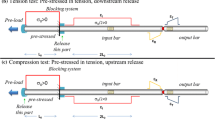Abstract
In order to restrain the geometric dispersion effect of the stress-wave propagation on conventional split-Hopkinson pressure bar (SHPB), the modified striker bar in Hopkinson bar-loaded test system is selected. Both the experiments and the simulation using ANSYS/LS-DYNA finite element method (FEM) were performed to investigate the modified effect. After verifying the effectiveness of the used program, six modified geometries of the striker bar were simulated. The optimization results in the simulation were further compared with that of the experiment. It was found that the geometric dispersion effect of the incident pulse under the same loading condition can be restrained effectively by modifying the striker bar. Moreover, the experimental incident pulse has a good agreement with that of the numerical simulation curves. By investigating various cases, several typical incident pulses can be obtained through different modified striker bars, and these modified approaches are simple and easy to be achieved.
Similar content being viewed by others
References
Chen, W.N., and Song, B., Split Hopkinson (Kolsky) Bar: Design, Testing and Applications, Springer, New York, NY (2010).
Gama, B.A., Lopatnikov, S.L., and Gillespie, J.W., “Hopkinson Bar Experimental Technique: A Critical Review,” Applied Mechanics Reviews 57(4):223–250 (2004).
Jiang, F., and Vecchio, K.S., “Hopkinson Bar Loaded Fracture Experimental Technique: A Critical Review of Dynamic Fracture Toughness Tests,” Applied Mechanics Reviews 62(6):060802 (2009).
Meyers, M.A., Dynamic Behavior of Materials, John Wiley & Sons, New York, NY (1994).
Wang, L.L., Foundations of Stress Waves, Elsevier, Amsterdam, The Netherlands (2011).
Davies, R.M., “A Critical Study of the Hopkinson Pressure Bar,” Philosophical Transactions of the Royal Society of London. Series A, Mathematical and Physical Sciences 240: 375–457 (1948).
Graff, K.F., Wave Motion in Elastic Solids, Courier Dover, Mineola, NY (1975).
Gray, G.T., Classic Split-Hopkinson Pressure Bar Testing, ASM International, Materials Park, OH, pp. 462–476 (2000).
Follansbee, P.S., and Frantz, C., “Wave Propagation in the Split Hopkinson Pressure Bar,” Journal of Engineering Materials and Technology 105(1): 61–66 (1983).
Gorham, D.A., “A Numerical Method for the Correction of Dispersion in Pressure Bar Signals,” Journal of Physics E: Scientific Instruments 16(6): 477–479 (1983).
Gong, J.C., Malvern, L.E., and Jenkins, D.A., “Dispersion Investigation in the Split Hopkinson Pressure Bar,” Journal of Engineering Materials and Technology 112(3): 309–314 (1990).
Christensen, R.J., Swanson, S.R., and Brown, W.S., “Split-Hopkinson-bar Tests on Rock Under Confining Pressure,” Experimental Mechanics 12(11): 508–513 (1972).
Ellwood, S., Griffiths, L.J., and Parry, D.J., “Materials Testing at High Constant Strain Rates,” Journal of Physics E: Scientific Instruments 15(3): 280–282 (1982).
Parry, D.J., Walker, A.G., and Dixon, P.R., “Hopkinson Bar Pulse Smoothing,” Measurement Science and Technology 6(5): 443–446 (1995).
Lok, T.S., Li, X.B., Liu, D., et al., “Testing and Response of Large Diameter Brittle Materials Subjected to High Strain Rate,” Journal of Materials in Civil Engineering 14(3): 262–269 (2002).
Frew, D.J., Forrestal, M.J., and Chen, W., “Pulse Shaping Techniques for Testing Brittle Materials with a Split Hopkinson Pressure Bar,” Experimental Mechanics 42(1): 93–106 (2002).
Frew, D.J., Forrestal, M.J., and Chen, W., “Pulse Shaping Techniques for Testing Elastic–plastic Materials with a split Hopkinson Pressure Bar,” Experimental Mechanics 45(2): 186–195 (2005).
Vecchio, K.S., and Jiang, F., “Improved Pulse Shaping to Achieve Constant Strain Rate and Stress Equilibrium in Split-Hopkinson Pressure Bar Testing,” Metallurgical and Materials Transactions A 38(11): 2655–2665 (2007).
Gerlach, R., Kettenbeil, C., and Petrinic, N., “A New Split Hopkinson Tensile Bar Design,” International Journal of Impact Engineering 50: 63–67 (2012).
Bertholf, L.D., and Karnes, C.H., “Two-Dimensional Analysis of the Split Hopkinson Pressure Bar System,” Journal of the Mechanics and Physics of Solids 23(1): 1–19 (1975).
Ram´ırez, H., and Rubio-Gonzalez, C., “Finite-Element Simulation of Wave Propagation and Dispersion in Hopkinson Bar Test,” Materials & Design 27(1): 36–44 (2006).
Kariem, M.A., Beynon, J.H., and Ruan, D., “Misalignment Effect in the Split Hopkinson Pressure Bar Technique,” International Journal of Impact Engineering 47: 60–70 (2012).
Naghdabadi, R., Ashrafi, M.J., and Arghavani, J., “Experimental and Numerical Investigation of Pulse-Shaped Split Hopkinson Pressure Bar Test,” Materials Science and Engineering A 539: 285–293 (2012).
Baranowski, P., Malachowski, J., Gieleta, R., et al., “Numerical Study for Determination of Pulse Shaping Design Variables in SHPB Apparatus,” Bulletin of the Polish Academy of Sciences Technical Sciences 61(2): 459–466 (2013).
Author information
Authors and Affiliations
Corresponding author
Rights and permissions
About this article
Cite this article
Zou, G.P., Shen, X.H., Chang, Z.L. et al. A Method of Restraining the Geometric Dispersion Effect on Split-Hopkinson Pressure Bar by the Modified Striker Bar. Exp Tech 40, 1249–1261 (2016). https://doi.org/10.1007/s40799-016-0125-6
Published:
Issue Date:
DOI: https://doi.org/10.1007/s40799-016-0125-6




